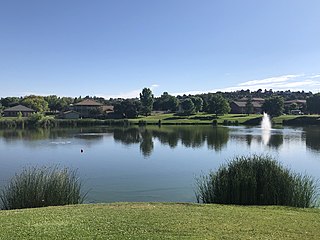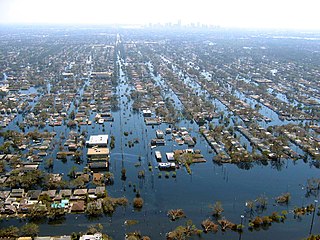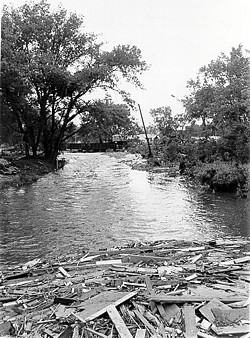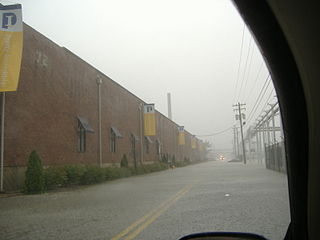
Payson is a town in northern Gila County, Arizona, United States. Due to Payson's location being very near to the geographic center of Arizona, it has been called "The Heart of Arizona". The town is surrounded by the Tonto National Forest, the largest of the six national forests in Arizona and is the ninth largest national forest in the United States.[1][2]

Prescott is a city & county seat of Yavapai County, Arizona, United States. As of 2020 Census, the city's population was 45,827.

A flash flood is a rapid flooding of low-lying areas: washes, rivers, dry lakes and depressions. It may be caused by heavy rain associated with a severe thunderstorm, hurricane, or tropical storm, or by meltwater from ice or snow flowing over ice sheets or snowfields. Flash floods may also occur after the collapse of a natural ice or debris dam, or a human structure such as a man-made dam, as occurred before the Johnstown Flood of 1889. Flash floods are distinguished from regular floods by having a timescale of fewer than six hours between rainfall and the onset of flooding.

A slot canyon is a long, narrow channel or drainageway with sheer rock walls that are typically eroded into either sandstone or other sedimentary rock. A slot canyon has depth-to-width ratios that typically exceed 10:1 over most of its length and can approach 100:1. The term is especially used in the semiarid southwestern United States and particularly the Colorado Plateau. Slot canyons are subject to flash flooding and commonly contain unique ecological communities that are distinct from the adjacent, drier uplands. Some slot canyons can measure less than 1 metre (3 ft) across at the top but drop more than 30 metres (100 ft) to the floor of the canyon.

Navajo Upper Antelope Canyon is a slot canyon in the American Southwest, on Navajo land east of Lechee, Arizona. It includes six separate, scenic slot canyon sections on the Navajo Reservation, referred to as Upper Antelope Canyon, Rattle Snake Canyon, Owl Canyon, Mountain Sheep Canyon, Canyon X and Lower Antelope Canyon. It is the primary attraction of Lake Powell Navajo Tribal Park, along with a hiking trail to Rainbow Bridge National Monument.

Oak Creek Canyon is a river gorge located in northern Arizona between the cities of Flagstaff and Sedona. The canyon is often described as a smaller cousin of the Grand Canyon because of its scenic beauty. State Route 89A enters the canyon on its north end via a series of hairpin turns before traversing the bottom of the canyon for about 13 miles (21 km) until the highway enters the town of Sedona.

Floods in the United States (2000–present) is a list of flood events which were of significant impact to the country during the 21st century, since 2000. Floods are generally caused by excessive rainfall, excessive snowmelt, storm surge from hurricanes, and dam failure.

The Black Hills Flood of 1972, also known as the Rapid City Flood, was the most detrimental flood in South Dakota history, and one of the deadliest floods in U.S. history. The flood took place on June 9–10, 1972 in the Black Hills of Western South Dakota. 15 inches (380 mm) of rain in a small area over the Black Hills caused Rapid Creek and other waterways to overflow. Severe flooding of residential and commercial properties in Rapid City occurred when Canyon Lake Dam became clogged with debris and failed in the late evening hours of June 9 resulting in 238 deaths and 3,057 injuries. Over 1,335 homes and 5,000 automobiles were destroyed. The value of property damage was estimated to be over US$160 million in 1972 dollars. Flooding also occurred in Battle, Spring, Bear Butte, and Boxelder creeks.

On August 4, 2009, a flash flood occurred and impacted Louisville and portions of the surrounding Kentuckiana region as a cold front and mesoscale convective system moved across the Midwestern United States. The National Weather Service estimated that between three and six inches of rain fell across the city in less than one hour, breaking all previous one-hour rainfall records in the area. Most of the downtown area was underwater, with the deluge reaching four feet (1.2 m) deep in places.

Havasu Creek is a stream in the U.S. state of Arizona associated with the Havasupai people. It is a tributary to the Colorado River, which it enters in the Grand Canyon.

The 2010 Madeira floods and mudslides were the result of an extreme weather event that affected Madeira Island in Portugal's autonomous Madeira archipelago on 20 February 2010. The flash flood killed 51 people, of whom 6 are still to be found, and injured 250. Around 600 people were left homeless.

Hurricane Linda was a strong tropical cyclone in September 2015 that resulted in heavy rains across portions of Mexico and the Southwestern United States. The seventeenth named storm, eleventh hurricane, and eighth major hurricane of the season, Linda developed southwest of Mexico from a low-pressure area on September 5. Under warm sea surface temperatures and low to moderate wind shear, the system intensified into Tropical Storm Linda by September 6 and a hurricane by the next day. A well-defined eye soon formed within the storm's central dense overcast and Linda reached its peak intensity as a 125 mph (205 km/h) Category 3 major hurricane on the Saffir–Simpson hurricane wind scale on September 8. Thereafter, the storm moved into a stable environment and an area of lower sea surface temperatures, causing rapid weakening. Convective activity dissipated and Linda degenerated into a remnant low on September 10. The lingering system persisted southwest of Baja California, ultimately opening up into a trough on September 14.
In mid-March 2019, monsoonal downpours caused widespread flooding and landslides across South Asia.
Between 25–28 September 2019, Pune, India, and its division received a heavy amount of rainfall which caused flash flooding. In addition to people lost to these floods, other rain-related incidents such as collapsed compound walls of buildings have killed at least 21 people. Three NDRF teams along with the Army was deployed in the district for rescue operations.

Hurricane Heather was one of the worst tropical cyclones to affect Arizona on record. The sixteenth tropical cyclone, eighth named storm, and fourth hurricane of the 1977 Pacific hurricane season, it began as a tropical disturbance off the west coast of Mexico on October 3. The next day, October 4, it developed into a tropical depression and then turned to the northwest. It was soon upgraded to Tropical Storm Heather. On October 5, Heather became a hurricane, and later that day its winds peaked at 85 mph (137 km/h). Heather began to turn north-northwest around this time. By October 6, it was re-designated a tropical storm. Moving north, Heather continued to weaken over cooler waters, and on October 7, the final advisory was issued, downgrading Heather to a tropical depression.

Hurricane Olivia was a powerful and destructive Category 4 hurricane, that brought damaging floods to California and Utah during September 1982. Olivia was the twenty-fourth tropical cyclone, eighteenth named storm, ninth hurricane, and fourth major hurricane of the active 1982 Pacific hurricane season. The storm was first noted as a tropical depression from a ship report off the southern coast of Mexico. Olivia then steadily intensified before becoming a Category 4 hurricane, and reaching its peak intensity with 1-minute sustained winds of around 145 mph (230 km/h), at 18:00 UTC on September 21. The hurricane then rapidly weakened as it passed west of mainland Mexico, before being last noted to the west of California on September 25, as a surface trough.
The 2021 floods and landslides in Sri Lanka are flash floods and mudslides which were caused from heavy torrential rainfalls during May and June 2021. As of 7 June 2021; the monsoon floods affected in about 10 districts, killing at least 17 persons including about 10 because of floods and 4 people because of mudslides. About 245,000 people were affected living in Colombo, Puttalam, Kandy, Kalutara, Kurunegala, Gampaha, Nuwara Eliya, Ratnapura and Galle. More than 800 houses were reported to have been damaged.















